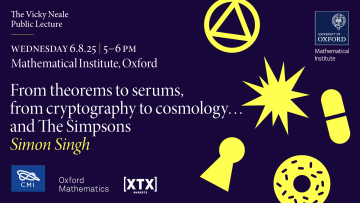Why Networks Matter: Embracing Biological Complexity - John Quackenbush, Harvard T.H. Chan School of Public Health
Tuesday 29 July at 2:00 pm in the Small Lecture Theatre, Department of Statistics
There will be a reception following the talk in the Ground Floor Social Area. There is no need to register – just join us on the day.
16:00
On the classification of quantum lens spaces
Abstract
16:00
Chern Characters of Bundles Associated to Almost Representations of Discrete Groups
Abstract
A group is said to be matricially stable if every function from the group to unitary matrices that is "almost multiplicative" in the point-operator norm topology is "close," in the same topology, to a genuine representation. A result of Dadarlat shows that even cohomology obstructs matricial stability. The obstruction in his proof can be realized as follows. To each almost-representation, a vector bundle may be associated. This vector bundle has topological invariants, called Chern characters, which lie in the even cohomology of the group. If any of these invariants are nonzero, the almost-representation is far from a genuine representation. The first Chern character can be computed with the "winding number argument" of Kazhdan, Exel, and Loring, but the other invariants are harder to compute explicitly. In this talk, Professor Forrest Glebe will discuss results that allow the computation of higher invariants in specific cases: when the failure to be multiplicative is scalar (joint work with Marius Dadarlat) and when the failure to be multiplicative is small in a Schatten p-norm.
13:00
Low-temperature transition of 2d random-bond Ising model and quantum infinite randomness
13:00
An N=4 SYM Collider at Finite Rank and Finite Coupling
Abstract
Energy correlations characterise the energy flux through detectors at infinity produced in a collision event. In CFTs, these detectors are examples of light-ray operators and, in particular, the stress tensor operator integrated over future null infinity. In N=4 SU(N_c) SYM, we combine perturbation theory, holography, integrability, supersymmetric localisation, and modern conformal bootstrap techniques to obtain predictions for such a collider experiment at finite coupling, both at finite number of colours, and in the planar limit. In QCD, the coupling runs with the angle between detectors, and there is a transition from perturbative to non-perturbative QCD. In N=4 SYM, a similar transition occurs when the coupling is varied, which we explore quantitatively. I will describe the physics underlying this observable and some of the methods used, particularly in regimes with analytical control.
Mini Course: Topological Phenomena in the Cuntz semigroup
Abstract
Mini Course: Topological Phenomena in the Cuntz semigroup
Mathematical Institute, University of Oxford
10-12 Sept 2025
This short mini course aims to introduce participants to the interplay between algebraic and differential topology and the Cuntz semigroup of C*-algebras. It will describe the use of the Cuntz semigroup to build C*-algebras outside the scope of the Elliott classification programme. There will be opportunities for participants to offer contributed talks.


